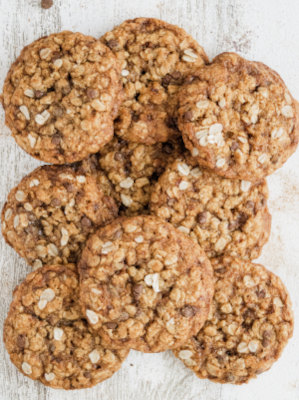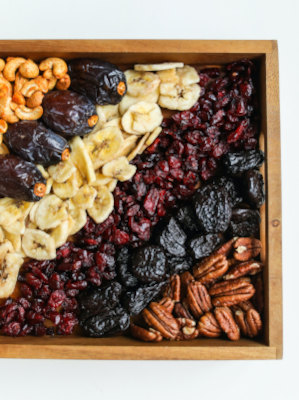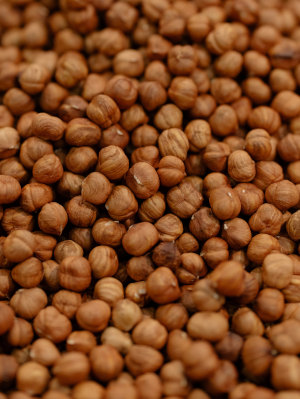This recipe is intended to serve a group of 5 to 6 individuals and yields approximately 12 cookies. The preparation time required for this recipe ranges from 30 to 60 minutes. These oatmeal cookies can offer a wide range of variations. They may potentially become your favorite cookies!

What you will need:
The kitchen supplies you will need for this recipe are:
An oven
A baking sheet
Parchment paper
A big bowl for mixing the ingredients
A grater
A scale
A tablespoon
The ingredients you will need for this recipe are:
175 grams of oat flakes
25 grams of sifted flour (options include chickpea, buckwheat, almond, or wheat flour)
75 grams of raisins or finely chopped apricots, dates, or other dried fruits soaked in warm water for 15 minutes
75 grams of chopped hazelnuts
¼ teaspoon of salt
1 teaspoon of cinnamon
4 tablespoons of agave syrup
2 apples, peeled, cored, and grated
50 grams of margarine or fragrant coconut oil at room temperature
Tip: You can experiment with different combinations of dried fruits and nuts. You can also add grated lemon zest or substitute 2 tablespoons of cocoa or 75 grams of chopped chocolate for the dried fruit. Additionally, feel free to use any type of flour.
Preparation:
- Preheat the oven to 170 degrees Celsius and line a baking sheet with parchment paper.
- In a bowl, combine all the ingredients thoroughly.
- Take a heaped tablespoon of the mixture at a time, shape it into a ball, and flatten it on the prepared baking sheet. Repeat until the baking sheet is filled. You can yield about 12 cookies with this mixture.
- Bake in the preheated oven for approximately 20 minutes, or until the edges of the cookies turn slightly brown.
- Allow the cookies to cool before enjoying them.
What makes these cookies healthy?
Oats
Oats have a well-balanced nutrient composition. They provide a good amount of carbohydrates and fiber. Oats also contain high-quality protein with essential amino acids. They contain significant amounts of manganese, phosphorus, magnesium, copper, iron, zinc, folate, vitamin B1, and vitamin B5. Oats also contain smaller amounts of calcium, potassium, vitamin B6, and vitamin B3. Furthermore, oats have antioxidants called avenanthramides that can lower blood pressure and relieve inflammation and itching.
Dried fruit
Dried fruit is fruit that has had most of its water removed through drying. This makes the fruit smaller and more energy-dense. Eating dried fruit can give you a lot of the vitamins and minerals you need each day, such as folate. However, some vitamins, like vitamin C, are reduced when fruit is dried. Dried fruit has a lot of fiber and antioxidants, especially polyphenols. Polyphenols can help with blood flow and digestion and can reduce the risk of many diseases.

Nuts
Nuts provide protein, B vitamins, vitamin E, and minerals like iron, potassium, selenium, magnesium, zinc, and copper. Moreover, they are high in fat, but it’s mostly the healthier unsaturated fat. They are a good source of omega-3 fatty acids, which are important for numerous bodily functions. Additionally, hazelnuts and almonds have the lowest amount of saturated fat.

Cinnamon
Cinnamon contains powerful antioxidants that can increase antioxidant levels in your blood and reduce inflammation. Inflammation is important for fighting infections and healing, but it can be harmful when it becomes chronic and targets your own tissues. It may also improve heart disease risk factors, blood sugar control, and show potential benefits for Alzheimer’s and Parkinson’s disease. Additionally, studies suggest that cinnamon may have protective effects against cancer, but more research is needed in humans.
Apples
Apples are a good source of fiber, such as pectin. Pectin is a soluble fiber that can help prevent constipation and may have a modest effect on lowering LDL cholesterol. It is also fermented by beneficial bacteria in the colon, producing short-chain fatty acids that may help prevent chronic diseases like certain cancers and bowel disorders. They also contain phytochemicals such as quercetin, catechin, chlorogenic acid, and anthocyanin, which have antioxidant and anti-inflammatory effects. Apples are also rich in vitamin C.
Chocolate
Both milk chocolate and dark chocolate are not considered healthy foods. However, when compared to milk chocolate, dark chocolate is a healthier option. Dark chocolate contains less sugar and no milk, but it has a higher amount of cacao. The higher cacao percentage in dark chocolate means it contains more flavanol. Flavanols are associated with the production of nitric oxide, which helps relax blood vessels and improve blood flow. By relaxing blood vessels, dark chocolate can lower blood pressure and contribute to overall health. Improved blood flow is crucial for preventing heart disease and stroke, as well as enhancing cognitive function by increasing blood flow to the brain.
Furthermore, dark chocolate may also have a positive impact on mood. Polyphenols, which are compounds found in plants along with flavanol, are known to be antioxidants that can lower cortisol, a stress hormone. Therefore, consuming dark chocolate may help reduce stress levels and contribute to a better overall mood.
Sources:
https://veganchallenge.nl/recepten/havermoutkoekjes/
https://www.healthline.com/nutrition/9-benefits-oats-oatmeal#antioxidants
https://www.healthline.com/nutrition/dried-fruit-good-or-bad#TOC_TITLE_HDR_6
https://www.bhf.org.uk/informationsupport/heart-matters-magazine/nutrition/are-nuts-good-for-you
https://www.healthline.com/nutrition/10-proven-benefits-of-cinnamon#TOC_TITLE_HDR_13
https://www.hsph.harvard.edu/nutritionsource/food-features/apples/
https://www.stmaryshealthcaresystem.org/brand-journalism/blogs/milk-chocolate-vs-dark-chocolate-is-one-healthier-than-the-other#:~:text=Dark%20chocolates%20can%20contain%20about,than%20sweet%2Dtasting%20milk%20chocolate.
